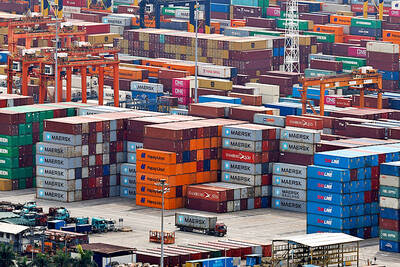A lone cement ribbon bisecting hundreds of kilometers of shale and scrub on the high plains of Mongolia’s Gobi may be a talisman or curse for nomadic herders who trace their lineage to the empire of Genghis Khan.
Carved into the Gobi by the Hong Kong-listed Mongolian Mining Corporation (MMC), the 245km two-lane road is scheduled to open next month, allowing the company to speed up cargoes of coal to China from its expanding Ukhaa Khudag mine.
Ukhaa Khudag is not well-known, but is situated on the northwest corner of Mongolia’s Erdenes-Tavan Tolgoi, the world’s biggest untapped coal mine with as much as 7.5 billion tonnes of reserves.
Some bankers say plans for an IPO next year to develop the prospect could fetch as much as US$15 billion.
The freshly paved highway is one of the first glimpses of a mining boom that will transform Mongolia’s fortunes.
However, many, including Mongolian President Tsakhia Elbegdorj, are worried that mining has already put the country’s fragile pastoral economy under strain and left a million nomads behind.
“Hundreds of rivers, streams and lakes have disappeared because of deforestation, climate change, and also partly because of irresponsible mining,” said Puntsag Tsagaan, the president’s senior adviser. “Our challenge is how to diversify our economy. I don’t want my children and my grandchildren to live in a different country called Minegolia — it has to be Mongolia. Therefore, we have to manage the mineral wealth in a better way.”
The road will remove a major logistical hurdle for MMC.
“We will start using it next month and it will have a total throughput capacity of about 18 million tonnes per annum — this year our total production will be 7 million tonnes so we no longer have logistics and transportation problems,” MMC chief financial officer Adilbish Gankhuyag said.
It is also a key part of the company’s commitment to protect the region’s ecosystem, which has been damaged by hundreds of overloaded coal trucks churning up grazing land, said Shurka Baigalmaa, MMC’s onsite manager at Ukhaa Khudag.
MMC is also committed to using the parched region’s water supplies efficiently, with Baigalmaa saying that 95 percent of water used at the mine’s washing plant would be recycled.
The open-cast mine is already 70 meters deep, and will eventually descend 300 meters, but she said the company would limit the impact by refilling exhausted seams using peat excavated from new mining areas further west.
However, mining can never be completely clean. Clouds of sulfurous dust drift across the site and Baigalmaa said they had not yet built screens to help contain the problem.
Apart from the thirsty crows circling the mine’s reservoir, there are few signs of life in South Gobi, where about 50,000 herders roam an area the size of England and Wales.
MMC said it was obliged to resettle people disrupted by mining construction, but many have abandoned the region already, frustrated by having to move their tents 20 times a year just to keep herds nourished.
Further north, at the Hustai National Park, 150km west of Ulan Bator, people are also paying the price of mining, said Khagvadorj, a herder with a large family and dozens of horses.
Sipping fermented mare’s milk in a crowded ger, a felt tent that many Mongolian nomads call home, Khagvadorj said dwindling pastures were having to support bigger and bigger herds as land concessions are handed over to miners.
“We are nomads, and we move from one place to another — the mining stops us from moving around. Mining is not a good thing for us because it is spoiling our pastoral land,” he said.
Tsagaan said mining, if managed properly, could bring in enough tax revenue to provide the education, infrastructure and prosperity that can turn Mongolia into “the Switzerland of the twenty-first century.”
However, turning a basic resource economy to a high-end banking and manufacturing center is a big leap for a country of 2.8 million people and a per capita income of US$3,600 last year.
Analysts say its future is more closely linked with China.
Mongolia, landlocked between Russia and China, exports all of its coal to its southern neighbor, China, and has long been wary of becoming a satellite valued only for its resources.
Chuluuntseren Otgochuluu, the director of Mongolia’s Economic Policy and Competitiveness Research Center, an independent think tank, said mining had done little for Mongolia and was “far more integrated with the Chinese economy than the domestic economy.”
Political leaders are sensitive to the issue and talk about “adding value” to raw material processing and developing other exports such as meat and other traditional rural industries.
“People talk about the resource curse, and we should learn from others, from the successes and from those who made mistakes,” Mongolian Prime Minister Sukhbaatar Batbold said.
However, as increasing numbers of herders abandon the land and rush to the city, Mongolia is racing to devise the right mix of policies to preserve its old ways of life, said Clyde Goulden, a Mongolian ecology expert with the US National Academy of Sciences.
“Herders tell us that mines are really causing a problem and that the water is deteriorating,” he said.
“There is no question there are herders giving up herding, and the question then is what are they going to do?” he said.

The Eurovision Song Contest has seen a surge in punter interest at the bookmakers, becoming a major betting event, experts said ahead of last night’s giant glamfest in Basel. “Eurovision has quietly become one of the biggest betting events of the year,” said Tomi Huttunen, senior manager of the Online Computer Finland (OCS) betting and casino platform. Betting sites have long been used to gauge which way voters might be leaning ahead of the world’s biggest televised live music event. However, bookmakers highlight a huge increase in engagement in recent years — and this year in particular. “We’ve already passed 2023’s total activity and

Nvidia Corp CEO Jensen Huang (黃仁勳) today announced that his company has selected "Beitou Shilin" in Taipei for its new Taiwan office, called Nvidia Constellation, putting an end to months of speculation. Industry sources have said that the tech giant has been eyeing the Beitou Shilin Science Park as the site of its new overseas headquarters, and speculated that the new headquarters would be built on two plots of land designated as "T17" and "T18," which span 3.89 hectares in the park. "I think it's time for us to reveal one of the largest products we've ever built," Huang said near the

China yesterday announced anti-dumping duties as high as 74.9 percent on imports of polyoxymethylene (POM) copolymers, a type of engineering plastic, from Taiwan, the US, the EU and Japan. The Chinese Ministry of Commerce’s findings conclude a probe launched in May last year, shortly after the US sharply increased tariffs on Chinese electric vehicles, computer chips and other imports. POM copolymers can partially replace metals such as copper and zinc, and have various applications, including in auto parts, electronics and medical equipment, the Chinese ministry has said. In January, it said initial investigations had determined that dumping was taking place, and implemented preliminary

Intel Corp yesterday reinforced its determination to strengthen its partnerships with Taiwan’s ecosystem partners including original-electronic-manufacturing (OEM) companies such as Hon Hai Precision Industry Co (鴻海精密) and chipmaker United Microelectronics Corp (UMC, 聯電). “Tonight marks a new beginning. We renew our new partnership with Taiwan ecosystem,” Intel new chief executive officer Tan Lip-bu (陳立武) said at a dinner with representatives from the company’s local partners, celebrating the 40th anniversary of the US chip giant’s presence in Taiwan. Tan took the reins at Intel six weeks ago aiming to reform the chipmaker and revive its past glory. This is the first time Tan